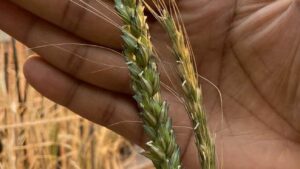An international consortium of public and private partners plans to sequence the genome of wild emmer, an ancestor of modern wheat, according to a report from SciDev.Net.
Scientists from the group say that the nutrient-rich wheat could yield ideas to address global hunger by making modern wheat varieties healthier and hardier.
Wild emmer is the progenitor of today’s durum and bread wheat varieties. It was one of the first crops to be domesticated during the dawn of agriculture, around 10,000 years ago in the Middle East.
“Wild emmer wheat can be naturally crossed with domesticated wheat, hence it is a potential source for wheat improvement,” says Assaf Distelfeld, a wheat geneticist at Tel Aviv University, Israel, and lead researcher in the project. Sequencing wild emmer wheat could assist efforts to improve the quality and yields of modern varieties, he says.
For example, wild emmer grain is rich in micronutrients such as iron and zinc. Transferring this trait to bread wheat could reduce malnutrition among people whose diet is based on this staple crop, the scientists say. According to the Food and Agriculture Organization of the United Nations, wheat provides roughly one-fifth of the calories eaten around the world.
“In addition, we hope to identify genes that enable wheat to grow better in tough environments, thus improving our food security,” Distelfeld says.
The completed genome could increase opportunities for breeding programs in the developing world to address hunger, which is one of the UN’s proposed sustainable development goals.
More information is available online at http://www.scidev.net/global/agriculture/news/wheat-sequencing-bolster-harvests.html?utm_source=link&utm_medium=rss&utm_campaign=global/global_rss.xml.










